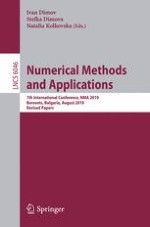This book constitutes the thoroughly refereed post-conference proceedings of the 7th International Conference on Numerical Methods and Applications, NMA 2010, held in Borovets, Bulgaria, in August 2010. The 60 revised full papers presented together with 3 invited papers were carefully reviewed and selected from numerous submissions for inclusion in this book. The papers are organized in topical sections on Monte Carlo and quasi-Monte Carlo methods, environmental modeling, grid computing and applications, metaheuristics for optimization problems, and modeling and simulation of electrochemical processes.
